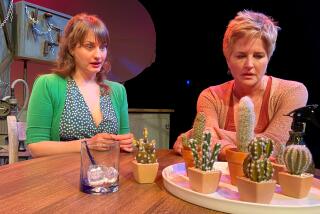‘Temptation of St. Antony’ mixes play, dance and avant-pop concert into a show that defies labels
In a gutted warehouse near Grand Central Market in downtown Los Angeles, a ragtag repertory is acting out a story by Gustave Flaubert in a cluttered set sourced primarily from Craigslist. Actors sing and musicians dance, as an agonized Saint Antony, the fourth century Egyptian monk, is tempted by the seven deadly sins.
“The Temptation of St. Antony,” a production by the company Four Larks, debuted in the same clandestine location last spring and has resurfaced with new touches and a new leading lady (Esther Hannaford, who plays several roles, including the Queen of Sheba).
The original six-week run, which Times critic Mark Swed described as “seriously imaginative, theologically post-apocalyptic, gravely yet wondrously immersive,” sold out and was nominated for seven Ovation Awards. (It won for best ensemble and music).
Classified as a “junkyard opera” by Four Larks, the show blurs the lines between dance, theater and opera. A cast of 12, all painted in white, use Flaubert’s 1874 book and its baroque language as a springboard to explore a pious man’s wrestling match with the world’s enticements.
A “prelude” art installation in an all-white foyer sets the mood with mountains of books and old cathode television sets. Inside a more traditional theater space (Antony’s cavern), the production unfolds.
“We used ‘immersive’ to talk about this project last year, and that I think can mean some specific things to some theater people — that it is more like a costume party, haunted house kind of thing,” said creative director Matthew Diafos Sweeney. “And this is not that. We make work in secret locations that have an immersive design component — where you enter the space, and the whole process is a part of the ritual of attending the event.”
Four Larks, at its core, is Sweeney and Sebastian Peters-Lazaro, both 32. The two met as students at UCLA, where they were motivated to dumpster-dive into disparate art forms and come up with a new amalgam. After moving to Oakland, they staged an immersive, walk-through musical performance in 2008 that spilled out of their house and onto neighboring roofs.
That inaugural production, “The Invitation,” laid the foundation for future projects: secretive, single-use sites featuring production and props harvested from second-hand junk, and an artistically fluid cast culled from their community of creatives
The pair spent four years creating work in Melbourne, Australia, and returned to L.A. in 2014. They introduced themselves to the city with a new spin on “Orpheus,” which was developed through the Getty Villa Theater Lab and staged inside a fabric warehouse in the fashion district.
Four Larks subsists solely on ticket sales and has no administrative staff. Sweeney — who wrote, co-composed the music and directed “St. Antony” — also takes your ticket upon arrival. This leanness, in part, is why the company has been able to trot out a new and improved “St. Antony.”
“Because we don’t necessarily have the resources that it would take to develop a piece like this, our initial development was fast and furious,” Sweeney said. “We were really excited with the piece that resulted from that, but it’s been great to come back and actually spend the time and go a little bit deeper.”
We set out to create a new form every time — the way that we’re engaging with a text, and the layers of the performance.
— Matthew Diafos Sweeney, creative director, Four Larks
“St. Antony” hasn’t had trouble finding an audience, despite evading easy classification, though Sweeney admitted the performance tends to attract a lot of their peers. (No one at Tuesday night’s performance looked older than 40.)
“The work is not alienating to anyone, but I think the most immediate response is from people who are our age,” Sweeney said. “Maybe that’s because the work is quite personal, so we’re speaking to our own experiences — or just that people are at a stage in their life where they’re more open to experiencing a different form of a thing.”
L.A. has seen a wave of artists doing site-specific, hidden-location, hard-to-define work of late, from the ambitious “Hopscotch,” an opera held in a fleet of moving cars, to magician Helder Guimarães’ “Borrowed Time” to the art installation “Petal Drop LA,” organized by a collective of anonymous artists.
“St. Antony” is mishmash theater put on by non-theater people — but Sweeney and Peters-Lazaro are quick to scrub out the bitter taste (at least to some potential audiences) of the word “experimental.”
“That creates a false dichotomy between experimental and accessible, which I think is probably not appropriate,” Sweeney said. “We set out to create a new form every time — the way that we’re engaging with a text, and the layers of the performance. But we’re also interested in creating something that is aesthetically compelling.”
This is where the term “junkyard opera” comes in handy, referring not only to the weathered copy machines and megaphones employed in “St. Antony,” but also to a rejection of elitism.
It speaks “to the grandeur of the opera,” Peters-Lazaro said, “but keeping it on a level that lets people not hold it in such reverence on a pedestal.
“There are a lot of things that are inherently theatrical and visually appealing, and the music is very engaging,” he said. “We’re always working to hit people on different levels of experience and attention and enjoyment.”
+++
“The Temptation of St. Antony’
Where: Basic Flowers, downtown Los Angeles location revealed after tickets are booked
When: Through Sept. 11
Tickets: $20-$50
Info: fourlarks.com
SIGN UP for the Essential Arts & Culture newsletter »
Follow The Times’ arts team @culturemonster.
ALSO
Captain Kirk, Klingons and an aria: How the Pacific Opera Project remade Mozart, ‘Star Trek’-style
Why does L.A. need its own summer classical music festival? For answers, look 6,000 miles away
Review: Shakespeare at the Bowl is much ado but about what?
More to Read
The biggest entertainment stories
Get our big stories about Hollywood, film, television, music, arts, culture and more right in your inbox as soon as they publish.
You may occasionally receive promotional content from the Los Angeles Times.






